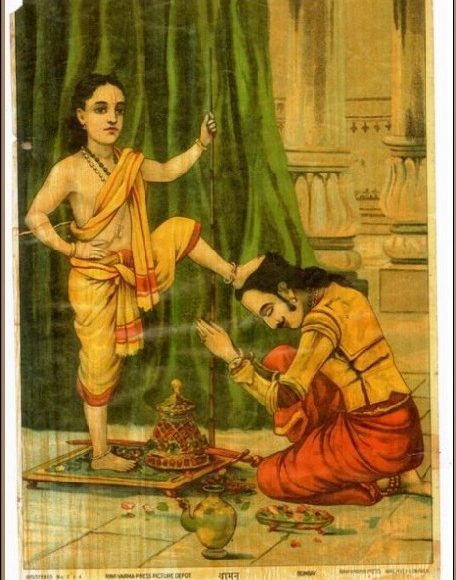BAWANA (VAMANA INCARNATION) Vishnu, who had assumed the form of Bawana (Vamana-dwarf), asked for two and a half steps of earth under some pretext, if (the demon king) Bali had recognised Him, why could he has been deceived for going to the nether-regions (Patala) ? (Prabhati M. l, p. 1344) O Lord! Thou has created the form of Bawana….. (Maru M. 5, p. 1082) Through his great penances, the good and virtuous demon king Bali had defeated Indra and subjugated the three worlds. The gods appealed to Vishnu for protection, who assumed the form of a dwarf (Vamana). He asked for two and a half steps of the earth from the king, but enlarged himself to such an enormous size that only with two steps, he covered all the three worlds. Out of the reverence for the king for his kindness and for the devotion of his grandfather Prahlada, Vishnu left Patala for him. See : Das Avatars and Bali
References :
1. Kohli, Surindar Singh, Dictionary of Mythological References in Guru Granth Sahib, 1993
Vamana, the fifth avatar of Lord Vishnu, holds a fascinating and symbolic role in Hindu mythology. Vamana’s incarnation as a dwarf Brahmin underscores Vishnu’s ability to use intelligence and humility to restore cosmic balance.
The Story of Vamana
Vamana’s tale revolves around the demon king Mahabali, who was renowned for his virtue and generosity but also sought dominance over the three worlds—Earth, Heaven, and the Netherworld. During Mahabali’s reign, the gods approached Vishnu to intervene, fearing they would lose their celestial kingdom to Mahabali.
Vishnu incarnated as Vamana, a humble and diminutive Brahmin, and approached Mahabali during a grand sacrificial ceremony. Vamana requested three paces of land as his alms, which Mahabali willingly granted despite warnings from his advisor, Shukracharya.
In a miraculous display, Vamana expanded to a gigantic form. With his first step, he covered the Earth; with the second, he claimed the heavens. When there was no space left for the third step, Mahabali humbly offered his own head, demonstrating his devotion and selflessness.
Significance
- Symbolism: Vamana’s form teaches the importance of humility and that power and pride must be tempered by dharma (righteousness).
- Mahabali’s Legacy: Mahabali was granted immortality and allowed to visit his kingdom once a year, an event celebrated as Onam in Kerala.
- Cosmic Order: Vamana’s intervention restored the balance between the gods and demons, ensuring the preservation of dharma.
Vamana’s story showcases Vishnu’s divine strategy and highlights the importance of virtue and humility. Let me know if you’d like to explore more avatars or their symbolism!
From a philosophical perspective, Vamana’s incarnation in Hindu mythology symbolizes profound truths about the relationship between humility, power, and the cosmic balance of dharma.
Humility Over Pride
Vamana’s dwarf form represents the virtue of humility, which stands in stark contrast to the pride and ambition embodied by King Mahabali. Despite Mahabali’s generosity, his desire to rule over the heavens and assert dominance led to a disturbance in the cosmic order. Vamana reminds us that true greatness lies not in outward displays of power but in the willingness to act selflessly and modestly.
Cosmic Justice and Dharma
The story illustrates the concept of dharma (righteousness) as central to the universe’s balance. While Mahabali’s intentions were not inherently evil, his actions tipped the scale toward adharma (unrighteousness) by challenging the natural hierarchy of the gods and demons. Vishnu’s intervention as Vamana reasserted the equilibrium, demonstrating that divine justice transcends personal ambition.
The Infinite Expanding Consciousness
Vamana’s transformation from a small dwarf to a colossal being is often interpreted as a metaphor for the potential of spiritual growth. The seemingly insignificant Vamana encompasses the entire cosmos, reminding us that the divine presence can expand beyond human comprehension. This expansion also emphasizes the interconnectedness of all existence, as even the smallest form holds infinite potential.
Mahabali’s Sacrifice
Mahabali’s surrender, offering his head as the third step, is emblematic of letting go of ego and embracing surrender to the divine. His humility in accepting Vamana’s dominance and his ultimate devotion highlight the importance of submission to higher powers and the acceptance of one’s place in the cosmic order.
Onam and Unity
The annual celebration of Onam in Kerala, tied to Mahabali’s legacy, philosophically emphasizes the ideals of equality, prosperity, and harmony. It serves as a reminder that virtue is not solely defined by power but by the ability to serve and uplift others.
Ultimately, Vamana’s story encourages reflection on the delicate balance between ambition and humility, power and surrender, and the eternal guidance of the divine in maintaining universal harmony. What resonates with you most about this tale?





